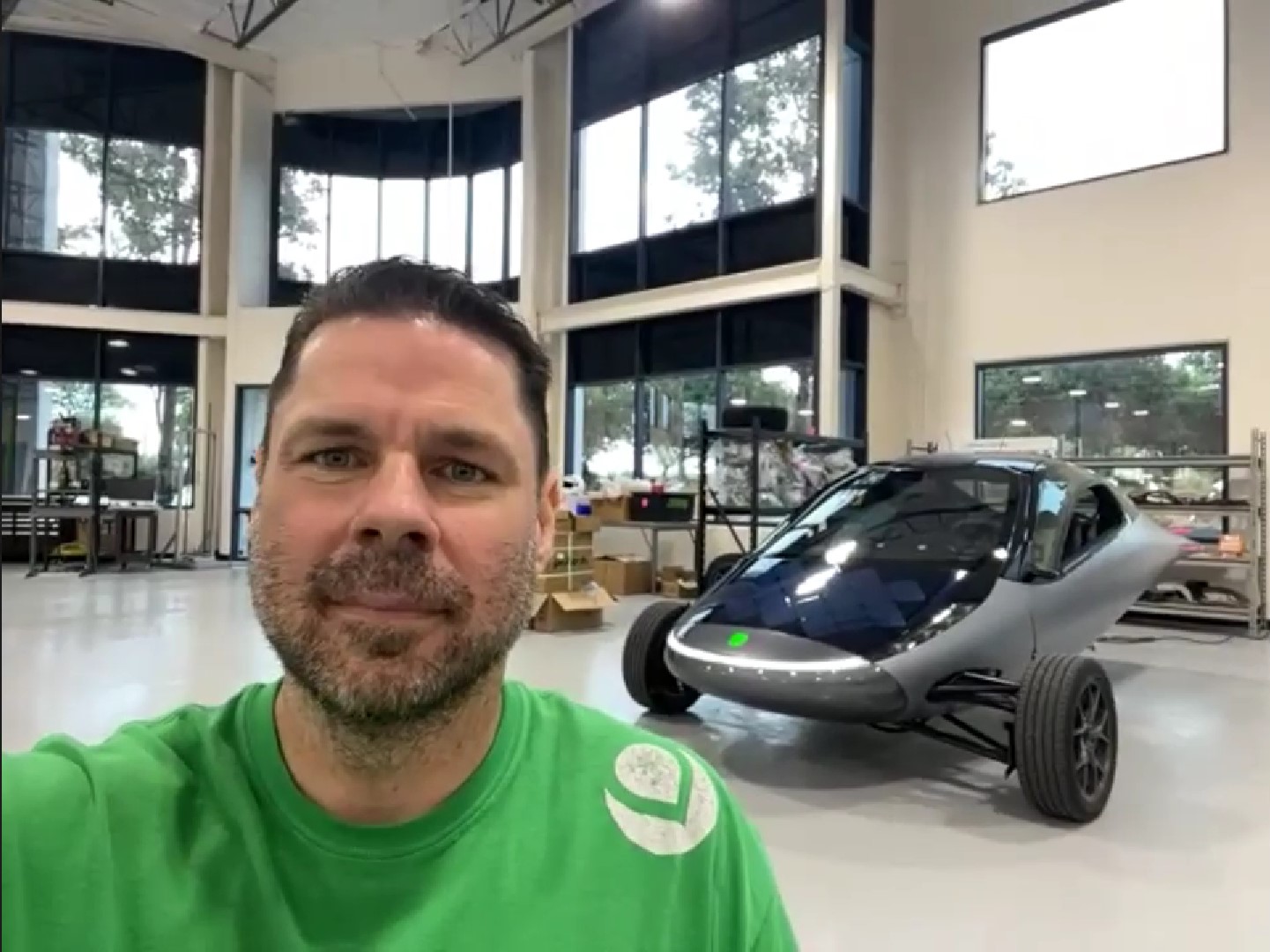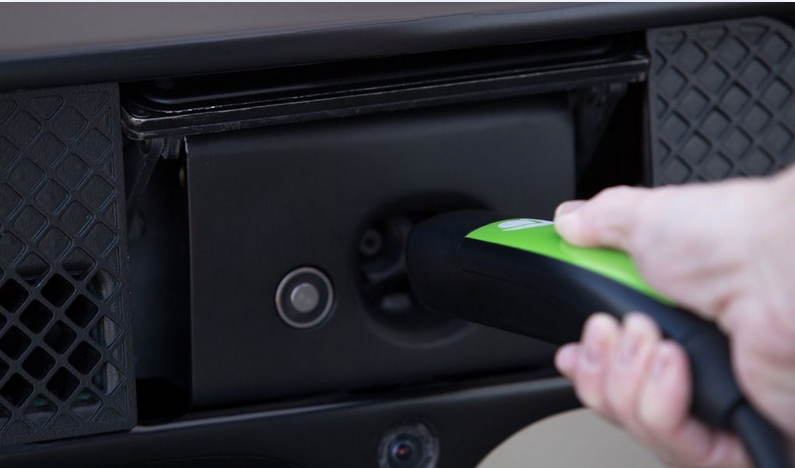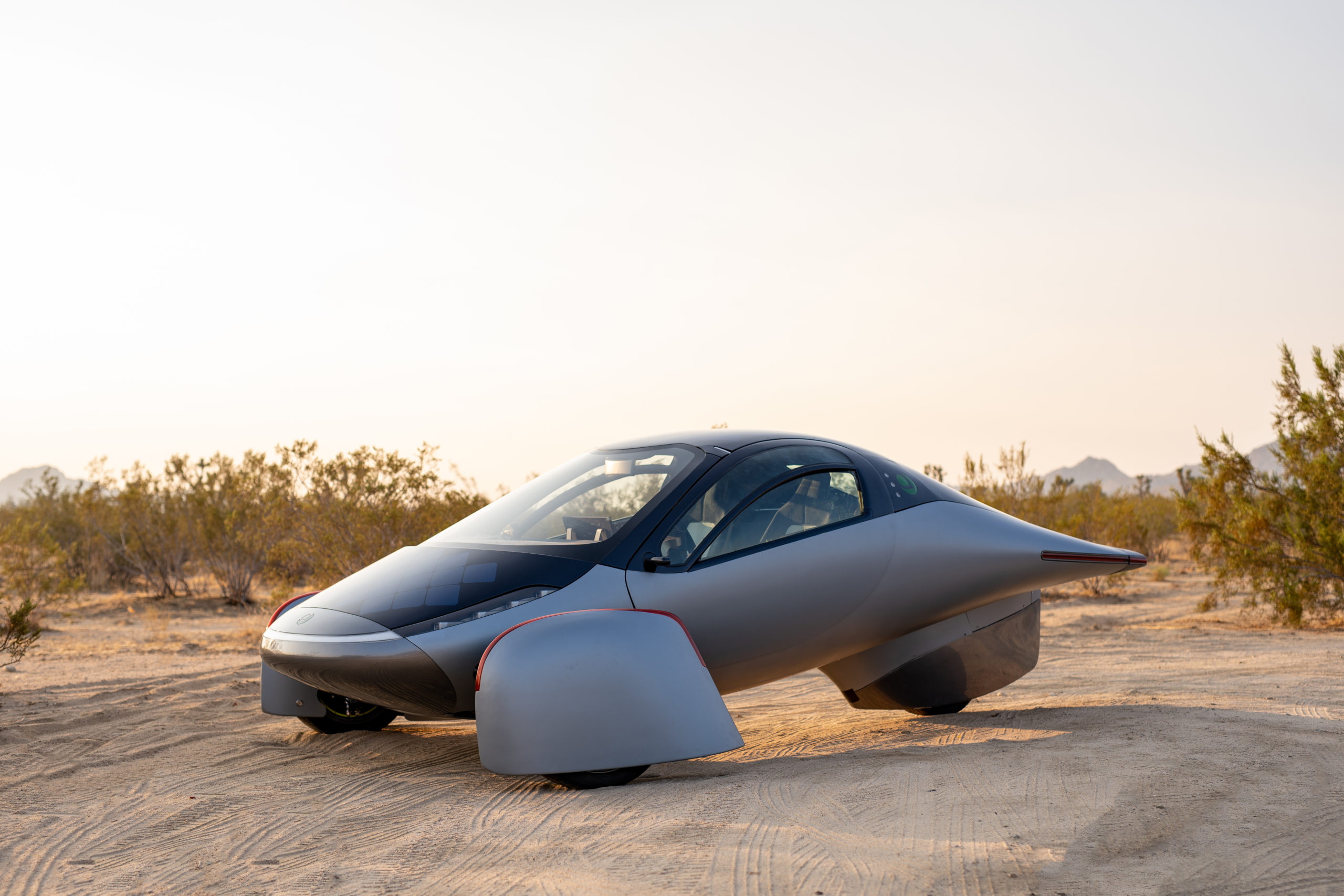I had the fantastic opportunity to talk with Aptera Co-Founder Chris Anthony on Friday. Our short half-hour conversation highlighted production timelines, vehicle design, sustainability, and more.
This weekend, Aptera is participating in the Fully Charged Show, an Electric Vehicle convention in San Diego, where they will be unveiling their Gamma vehicle. According to Co-CEO Chris Anthony, this vehicle is the last stop before attempting to enter production next year. And while the company has a long way before delivering orders, they have over 30,000 reservation holders eagerly awaiting the vehicle’s release.

Design language –
The first question I had to ask Mr. Anthony about was the design language of Aptera’s first vehicle. Specifically, what is Aptera attempting to make consumers think and feel when they see the car for the first time?
The first thing that came to the CEO’s mind was capability; he wants consumers to feel like Aptera is just as capable as any other vehicle and can even do more with its unique energy generation capabilities. When he has had the opportunity to have people sit in the vehicle, testers have stated that the vehicle is comfortable, and Mr. Anthony hopes the vehicle’s driving dynamics only further improve the experience.
Capability as a “do everything” vehicle –
Besides the Aptera’s beautiful design, many are looking to buy the Aptera for its function. Coming out of COVID lockdowns, many consumers have been spending more time outside the house, hiking and mountain biking, meeting with friends and family, and taking trips to local events and scenic locations. How has Aptera engineered capability into their vehicle to perform these tasks?
Mr. Anthony points to the car’s solar power generation and the surprising amount of interior space as two critical features in helping people use their vehicles in everyday life. The car’s numerous solar cells mean the vehicle can go further and do more things, which is the ultimate goal of capability. At the same time, the vehicle’s interior is surprisingly spacious, with seven feet of space behind the front seats to the tail; enough room to camp in the vehicle, throw in their mountain bikes, or just travel with their dog.
Customization –
A key part of how many people interact with vehicles today is how they make them their own, customizing the look, feel, and capabilities of the vehicle to best suit their needs. Aptera is not only in support of this goal but is actively working with third-party suppliers to make that dream a reality.
The CEO clarified that Aptera would be more than willing to supply third-party accessory makers with everything from dimensions to CAD files to detailed systems information. He says, “We are happy to share information to help our users find [the vehicle] to be more useful.” As he would note later in the interview, this stems from a “right to repair mindset.”
Possible use of the Tesla Connector –

Aptera previously announced that they were not only attempting to include the Tesla connector on their vehicle but also attempting to make the connector the U.S. standard EV connector. However, it remains unclear if Aptera will include the connector in the vehicle, and doubtful that the Tesla Connector would become the US standard.
Nonetheless, Mr. Anthony stood behind the engineering of the Tesla connector. Foremost, he cited the connector’s ease of use and smaller size, which makes it far easier to maneuver than other connector types. But the connector also benefits from supporting the vast majority of electric vehicles in the U.S.
The CEO even went as far as saying that the U.S. should be spending more money supporting Tesla supercharger locations as long as the government plans to expand EV charging anyway.
Aptera’s future goals –
It is clear that Aptera will be focused on getting to production and delivering to their over 30,000 reservation holders in the immediate future. But if the company can achieve these goals, where does the CEO see the company’s next focus?
First, Mr. Anthony doesn’t see the company abandoning the two-door/two-seater form factor. He argues that the Aptera is an ideal complimentary car, helping you complete your daily commute and essential activities that don’t require a lot of space.
Perhaps more excitingly, the CEO did hint at the possibility of multiple variants of the Aptera, a commercial version or a version with more cargo capacity, for instance. No other details are known about these ideas yet.
Production timeline –
With the unveiling of Aptera’s Gamma vehicle this weekend, the company will now be shifting to getting to production as soon as next year. And while the CEO acknowledged that the timeline might not be as fast as some have wanted, he believes in doing the process correctly the first time and hopefully avoiding future issues.
“We have the good graces of our reservation holders to do it right…”
With Aptera’s current production facility in California, they aim to produce 20,000 units within the first year, meaning that filling the 30,000 reservations will take roughly a year and a half. However, any prediction outside of the company is pure conjecture.
Sustainability –
Consumers now more than ever are looking to get the best option for them and the best choice for the planet. Automakers recognize this, and many produce vehicles with sustainable interior parts, recycled metal components, and more. What does the pursuit of sustainability look like for Aptera?
The most sustainable material on Earth is the material not mined, was the conclusion of Mr. Anthony. While others may have been looking to use more sustainable materials, Aptera has pointed itself at using fewer materials in the first place. Aptera achieves this by producing a smaller vehicle, pursuing low curb weight, and reducing the number of interior components.
The pursuit of lightweight sustainability has trickle-down effects as well. Because of the vehicle’s low weight, it requires less energy to move and hence can use fewer batteries to achieve the same range, once again reducing weight (a positive feedback loop).
Ultimately, Mr. Anthony notes that fewer rare earth minerals are mined, and the vehicle as a whole becomes a more sustainable option for consumers. More specifically, Aptera uses 30% of the metal found in a typical vehicle, uses recycled composite materials for its exterior body panels, and uses recycled cloth and plastics on the interior.
The long-term goal is to have these vehicles on the road 50 years from now via upgraded parts along the way; better batteries, improved solar cells, replaceable interior pieces, etc.
Efficiency and beauty –
Manufacturers worldwide have been using aerodynamics to improve efficiency since the car’s inception. But perhaps most recently, due to the limitations of battery capacity, this pursuit has resulted in finding the most efficient shape possible, arguably at the cost of design. While vehicles like the Lucid Air and Mercedes EQS may have been beautiful in previous years, with the introduction of the Volkswagen ID Aero, it is clear that manufacturers are willing to trade unoriginality for efficiency.
Mr. Anthony doesn’t think that this has to be the case. In his response to this issue, he notes that Aptera proves that new and exciting designs can still be made in different form factors while still achieving maximal efficiency.
Are smaller vehicles the future? –
Aptera has highlighted the numerous benefits of producing smaller form factor vehicles. They can be more efficient, reduce manufacturing costs, be more aerodynamic, and be more sustainable. But are these motivators enough to get Americans to buy smaller vehicles in the future?
The CEO doesn’t believe so. Americans are obsessed with huge vehicles, evidenced by exceptionally high SUV and Truck sales. But perhaps, if anything, Aptera can show Americans what future transportation could look like, and if they are willing to give it a chance, maybe it will even change hearts and minds.
Aptera CEO Chris Anthony was incredibly gracious in giving Teslarati a piece of his busy schedule. If you want to learn more about the company’s vehicle, go to their website. And if you happen to be in the San Diego area, it’s worth the trip to the Fully Charged Show to check out the Aptera booth and the numerous other manufacturers attending the event.
William is not an Aptera ambassador, order holder, or investor.
What do you think of the article? Do you have any comments, questions, or concerns? Shoot me an email at william@teslarati.com. You can also reach me on Twitter @WilliamWritin. If you have news tips, email us at tips@teslarati.com!

Elon Musk
Starlink achieves major milestones in 2025 progress report
Starlink wrapped up 2025 with impressive growth, adding more than 4.6 million new active customers and expanding service to 35 additional countries, territories, and markets.

Starlink wrapped up 2025 with impressive growth, adding more than 4.6 million new active customers and expanding service to 35 additional countries, territories, and markets. The company also completed deployment of its first-generation Direct to Cell constellation, launching over 650 satellites in just 18 months to enable cellular connectivity.
SpaceX highlighted Starlink’s impressive 2025 progress in an extensive report.
Key achievements from Starlink’s 2025 Progress
Starlink connected over 4.6 million new customers with high-speed internet while bringing service to 35 more regions worldwide in 2025. Starlink is now connecting 9.2 million people worldwide. The service achieved this just weeks after hitting its 8 million customer milestone.
Starlink is now available in 155 markets, including areas that are unreachable by traditional ISPs. As per SpaceX, Starlink has also provided over 21 million airline passengers and 20 million cruise passengers with reliable high-speed internet connectivity during their travels.
Starlink Direct to Cell
Starlink’s Direct to Cell constellation, more than 650 satellites strong, has already connected over 12 million people at least once, marking a breakthrough in global mobile coverage.
Starlink Direct to Cell is currently rolled out to 22 countries and 6 continents, with over 6 million monthly customers. Starlink Direct to Cell also has 27 MNO partners to date.
“This year, SpaceX completed deployment of the first generation of the Starlink Direct to Cell constellation, with more than 650 satellites launched to low-Earth orbit in just 18 months. Starlink Direct to Cell has connected more than 12 million people, and counting, at least once, providing life-saving connectivity when people need it most,” SpaceX wrote.
News
Giga Nevada celebrates production of 6 millionth drive unit
To celebrate the milestone, the Giga Nevada team gathered for a celebratory group photo.

Tesla’s Giga Nevada has reached an impressive milestone, producing its 6 millionth drive unit as 2925 came to a close.
To celebrate the milestone, the Giga Nevada team gathered for a celebratory group photo.
6 million drive units
The achievement was shared by the official Tesla Manufacturing account on social media platform X. “Congratulations to the Giga Nevada team for producing their 6 millionth Drive Unit!” Tesla wrote.
The photo showed numerous factory workers assembled on the production floor, proudly holding golden balloons that spelled out “6000000″ in front of drive unit assembly stations. Elon Musk gave credit to the Giga Nevada team, writing, “Congrats on 6M drive units!” in a post on X.
Giga Nevada’s essential role
Giga Nevada produces drive units, battery packs, and energy products. The facility has been a cornerstone of Tesla’s scaling since opening, and it was the crucial facility that ultimately enabled Tesla to ramp the Model 3 and Model Y. Even today, it serves as Tesla’s core hub for battery and drivetrain components for vehicles that are produced in the United States.
Giga Nevada is expected to support Tesla’s ambitious 2026 targets, including the launch of vehicles like the Tesla Semi and the Cybercab. Tesla will have a very busy 2026, and based on Giga Nevada’s activities so far, it appears that the facility will be equally busy as well.
News
Tesla Supercharger network delivers record 6.7 TWh in 2025
The network now exceeds 75,000 stalls globally, and it supports even non-Tesla vehicles across several key markets.

Tesla’s Supercharger Network had its biggest year ever in 2025, delivering a record 6.7 TWh of electricity to vehicles worldwide.
To celebrate its busy year, the official @TeslaCharging account shared an infographic showing the Supercharger Network’s growth from near-zero in 2012 to this year’s impressive milestone.
Record 6.7 TWh delivered in 2025
The bar chart shows steady Supercharger energy delivery increases since 2012. Based on the graphic, the Supercharger Network started small in the mid-2010s and accelerated sharply after 2019, when the Model 3 was going mainstream.
Each year from 2020 onward showed significantly more energy delivery, with 2025’s four quarters combining for the highest total yet at 6.7 TWh.
This energy powered millions of charging sessions across Tesla’s growing fleet of vehicles worldwide. The network now exceeds 75,000 stalls globally, and it supports even non-Tesla vehicles across several key markets. This makes the Supercharger Network loved not just by Tesla owners but EV drivers as a whole.
Resilience after Supercharger team changes
2025’s record energy delivery comes despite earlier 2024 layoffs on the Supercharger team, which sparked concerns about the system’s expansion pace. Max de Zegher, Tesla Director of Charging North America, also highlighted that “Outside China, Superchargers delivered more energy than all other fast chargers combined.”
Longtime Tesla owner and FSD tester Whole Mars Catalog noted the achievement as proof of continued momentum post-layoffs. At the time of the Supercharger team’s layoffs in 2024, numerous critics were claiming that Elon Musk was halting the network’s expansion altogether, and that the team only remained because the adults in the room convinced the juvenile CEO to relent.
Such a scenario, at least based on the graphic posted by the Tesla Charging team on X, seems highly implausible.










